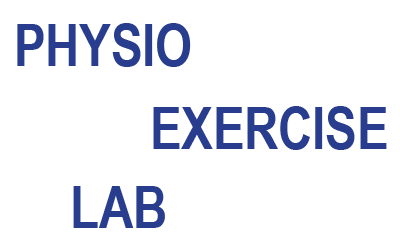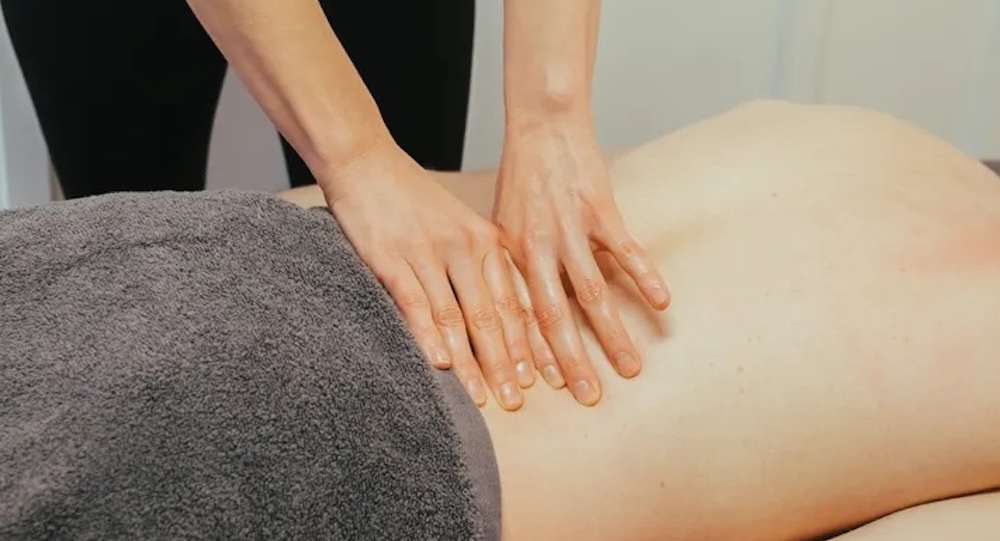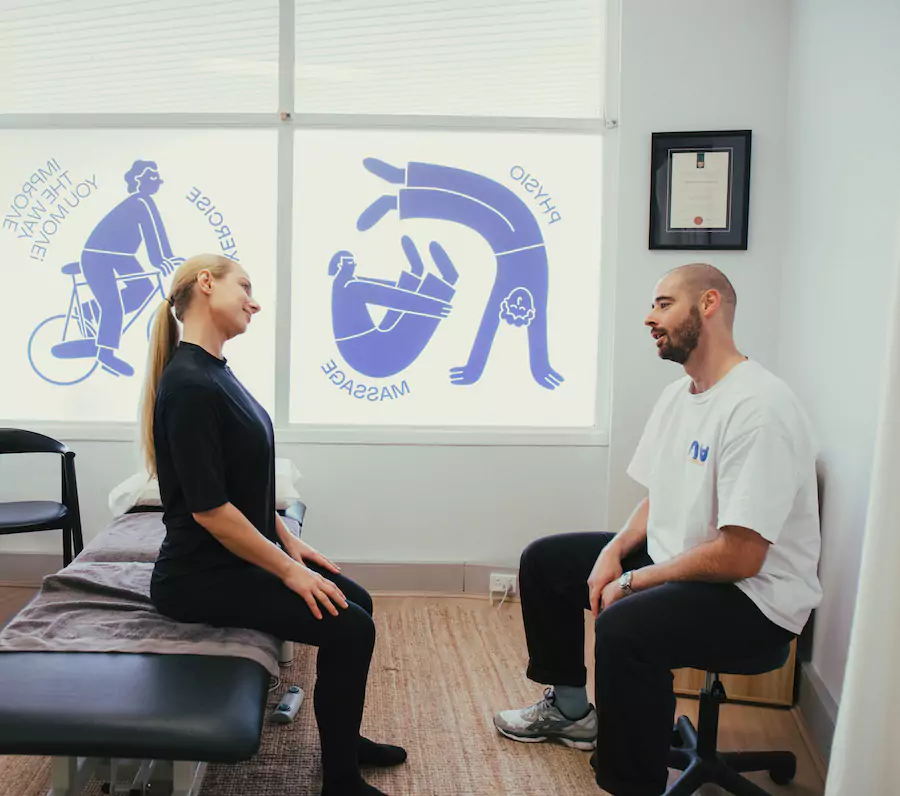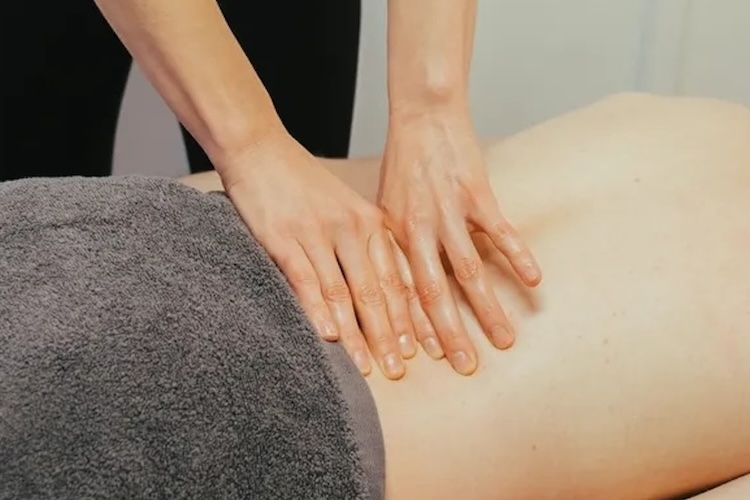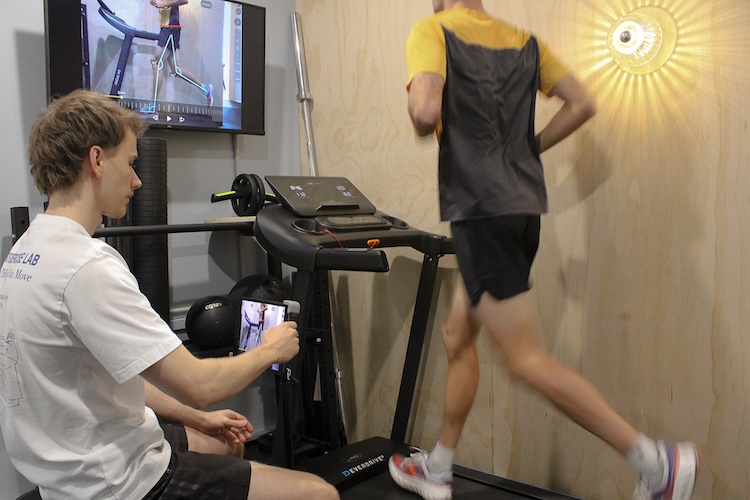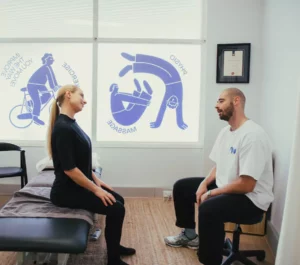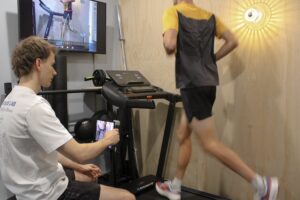Back pain is a problem for millions of Australians but simple mobility and exercise may get your back moving and offer some relief.
If you are looking for a simple way to feel better, here is a list of 14 of the best physio exercises for lower back pain.
Many of these lower back exercises are suitable for all fitness levels, can be completed with minimal space, and require no equipment.
The Best Physio Exercises for Lower Back Pain
- Knee to Chest Stretch
- Knee Rotation or Lower Back Rotation
- Cat/Cow Stretch
- Child’s Pose
- Foam Rolling
- Pelvic Tilts
- Spiky Ball Roll on Glutes
- Hip Flexor Stretches
- Piriformis Stretches
- Thread the Needle
- Hamstring Stretches
- Back Extensions or Cobras
- Bird-Dog Pose
- Segmental Bridge
How to Do These Lower Back Physio Exercises
I promote movement when I’m working with patients with low back pain or stiffness. Whether it is extending or bending, I like to remind patients (especially those who are pain-free) to stay moving.
At my clinic, we encourage whole compound movements in which their lower limbs, back, and trunk work together.
Our list of physio exercises for lower back pain is good as a general guide for most people with mild back stiffness or discomfort or those looking to maintain lower back mobility. However, this is not a one-size-fits-all plan.
Before starting any exercise regimen, always check with your healthcare provider. The best physio exercises for lower back pain exercises are based on the individual’s injury and movement restrictions.
1. Knee to Chest
The knee-to-chest stretch is one of the best physio exercises for lower back pain as it:
- May help decrease lower back pain and stiffness
- Helps promote spinal flexibility
- May help increase joint flexibility
How to do the knee-to-chest stretch
- Lie on your back with legs extended
- Bend your left leg and use both hands to pull your left knee up toward your chest
- Hold for 5 to 10 seconds
- Release your left knee and return to the station position
- Repeat with the right leg
- Complete the stretch 2 to 3 times on each side
If you find one leg too hard, lie on your back with feet flat on the floor. Bring both knees to the chest at the same time, hold for 5 to 10 seconds, and release back to the original position
2. Knee Rotation or Lower Back Rotation
If you know someone with lower back pain, you’ve probably seen them doing this exercise at some point. It offers a deep yet gentle stretch and sometimes offers an instant reduction in tightness.
Lower back rotation is good for reducing lower back pain as it:
- May offer an immediate reduction in lower back tightness
- Provides a gentle spinal twist
- Promotes mobility and flexibility
How to do lower back rotation/knee rotation
- Lie on your back with your knees bent and feet flat on the floor
- Keeping your lower back and shoulders pressed to the floor, slowly lower your knees to your left side (you should feel a good stretch but it shouldn’t feel forced or strained)
- Hold for 5 to 10 seconds
- Slowly return your knees to the starting position
- Repeat by lowering your knees to the right side
- Repeat 10 times on each side
3. Cat/Cow Stretch
This classic yoga pose is an excellent all-around stretch. I love doing this pose as part of my morning stretching routine to help loosen up and get ready for the day.
The cat-cow stretch is one of the best physio exercises for lower back pain as it:
- Increases spine, shoulder, and neck flexibility
- Stretches the back, chest, abdomen, and hips
- Strengthens the spine
- Helps relieve tension in the back and neck
How to do the cat-cow stretch
- Kneel on your hands and knees, with shoulders in line with your hands
- Slowly curl your back by pulling your belly button to your spine and bringing your chin toward your chest
- Slowly arch your back letting your belly move toward the floor as you bring your chin toward the ceiling
- Return to the starting position and repeat 5 to 10 times, up to twice a day
4. Child’s Pose
Another classic yoga pose that doubles as an excellent back stretch is child’s pose. This position makes an excellent addition to a morning or evening stretching routine.
The child’s pose is good for lower back pain as it:
- Is relaxing and soothing
- Promotes flexibility and mobility in the pelvis and hips
- May decrease back, hamstring, and shoulder pain
- Stretches the lower back hips, glutes, thighs, and, neck
How to do child’s pose
- Kneel on the floor with your knees apart and big toes touching
- Exhale as you reach out in front of you and fold forward, slowly lowering your chest toward the floor
- Work up to holding this resting pose for 30 seconds
- Slide your palms under your shoulders and press firmly through your palms to return to the starting position
- Repeat up to 5 times
5. Foam Rolling
There are many variations of foam rolling for back pain, but this option is one of my favourites. Do not foam roll your lower spine directly as this is not recommended.
Foam rolling is a good way to soothe lower back pain as it:
- Increases blood flow to the muscles
- Helps reduce muscle stiffness and soreness
- Promotes increased flexibility and range of motion
- May support muscle recovery
- Help ease muscle tension
How to do foam rolling for back pain
- Place the foam roller behind you as you sit on the ground
- Lower yourself so the foam roller is under your mid/upper back
- Keep your glutes on the ground
- Gently and slowly extend your spine backward
- Hold for up to 30 seconds and repeat up to 3 times a day
6. Pelvic Tilts
Pelvic tilts can be beneficial as they:
- May improve lumbo/pelvic dissociation and mobility
- Help strengthen the core and lower back muscles
- Reduce stiffness and pain in the lower back
- Are extremely gentle and suitable for almost any fitness level
How to do pelvic tilts
- Lay on your back with arms at your sides and legs bent with knees flat on the floor
- Exhale as you activate and squeeze your lower abdominal and gluteal muscles to tilt your pelvis slightly upwards
- Hold this contracted position for several seconds
- Relax and allow your pelvis to come back toward the ground
- Repeat 20 to 30 times
7. Spiky Ball Roll on Glutes
I like to do this one if my back is stiff or if I was sitting a lot that day — I often find instant relief from this exercise.
A spiky ball can be helpful for your lower back as:
- Tight glutes can cause lower back pain, so this move helps ease tension and offer relief from back pain by deeply massaging the glutes
- It helps prevent biomechanical imbalances from tight glutes
- It helps strengthen and stabilise the lower spin
How to do the spiky ball roll on glutes
- Sit down on the floor with your right leg outstretched and leg leg bent with your left foot flat on the floor and a spiky ball placed next to your right glute
- Lift yourself up and gently lower the fleshy part of your right glute onto the ball, your right leg should be straight and your left leg should be bent
- Roll your right glute in circular motions over the spiky ball several times, working your way up to 30 to 60 seconds
- Lift yourself up and off the ball and return to the starting position
- Repeat on your left glute
8. Hip Flexor Stretches/Low Lunge Position
Tight hip flexors can contribute to lower back pain by pulling down on the spine. This causes the body to lean forward, straining the lower back muscles.
Why hip flexor stretches can help with lower back pain as they:
- Help improve flexibility and mobility in the hips and pelvis
- Stretch the hip flexors and quads, alleviating pressure on the back
How to do hip flexor stretches/low lunges
- From a kneeling position, step your left leg forward, keeping your knee in line with your ankle
- Sink into this position, feeling a deep stretch in your right hip flexor
- Work your way up to holding this stretch for 30 seconds
- Press through your left foot to return to the starting position
- Repeat on your right leg
- Perform this stretch up to 5 times a day on each leg
9. Piriformis Stretches
If you sit for long periods or do repetitive motions for your job, you may have a tight piriformis. This is a small muscle deep within the glutes that can lead to lower back pain if it is tight.
Piriformis stretches can:
- Help reduce lower back tightness to alleviate pain
- Help improve range of motion in the lower back and pelvic region
How to do the piriformis stretch
- Lie on your back, with legs extended straight out on the floor
- Bend your left knee to lift your leg
- Using your right hand, gently pull your left leg toward your right shoulder
- Hold for 15 to 30 seconds
- Lower your leg to return to the starting position
- Repeat on the other side
- Repeat 2 to 4 times on each side
10. Hamstring Stretches
For lower back pain, hamstring stretches can:
- Reduce hamstring tightness, which can contribute to lower back pain
- Improve hamstring flexibility
How to do hamstring stretches
- Lay on your back, with your left leg bent with left foot flat on the floor and right leg in the air
- Loop a resistance band around the sole of your right foot and slowly straighten your right leg, holding the band with both hands
- Use the resistance band to gently pull your right leg closer to you
- Once you feel a good stretch (but not strain), hold for 30 seconds
- Release and repeat on your other side
- Repeat up to 5 times a day
11. Back Extensions or Cobra Stretch
If you’ve done yoga, you’re likely familiar with the cobra stretch. Also known as back extensions, this exercise requires a fair amount of flexibility in the lower back. If it feels too difficult, don’t force it.
These offer many benefits, including:
- Improving overall back flexibility
- Promoting mobility in the lower and upper back
- Reducing lower back tightness
- Helping open the neck and chest to counteract the effects of sitting for long periods (if you work a desk job, I highly recommend this stretch!)
How to do the cobra pose
- Lay on your stomach with palms on the ground near your chest
- Press up through your palms, slowly lifting your chest off the floor and extending your lower back
- Slowly bend your elbows to lower your chest back to the ground
- Repeat 10 times for a total of 3 sets
12. Thread the Needle
Thread the needle is one of my favourite mid to low back exercises when I’m feeling a little stiff or tight. It offers a deep, satisfying stretch but it is still a gentle exercise.
The thread the needle stretch is excellent for both the upper and lower back, and can:
- Help release tension in the shoulders and upper back
- Promote mobility and flexibility of the upper and lower back
- Help alleviate lower back pain
How to do the thread the needle stretch
- Start in the tabletop position on all fours (hips stacked above knees and shoulders stacked above the wrists)
- Lift your left hand off the ground and thread it underneath your right arm, keeping your left palm facing up
- Keep your hips high as you slowly lower your chest toward the ground to deepen the stretch
- Press firmly on your right palm and bring your left hand back underneath you to return to the starting tabletop position
- Repeat on the other side
- Work up to a total of 10 times on each side
- Repeat throughout the day for up to 3 to 5 times a day
13. Bird-Dog Pose
The bird-dog pose:
- Targets the entire body
- Promotes increased range of motion
- May help reduce low back pain
- Helps strengthen the muscles in the back, hips, and core
- Improves balance
How to do the bird dog pose
- Begin in the tabletop position on all fours, with shoulders aligned over the hands and hips over the knees
- Squeeze your shoulder blades together as you raise your left arm until your left shoulder is parallel to the floor and lift your right leg until your right hip is parallel to the floor
- Keep your spine neutral and lower abdominals engaged
- Hold the position for several seconds before slowly lowering your arm and leg back down to the starting position
- Repeat on the other side, raising your right arm and leg leg
- Do a total of 8 to 12 reps on each side and 2 to 3 sets total
14. Segmental Bridge
Why the segmental bridge is one of the best physio exercises for lower back pain:
- Helps strengthen the glutes, core, hamstrings, and lower back muscles
- Helps increase the flexibility of the spine
- May decrease lower back pain
- Does not place any pressure on the lower back
- Offers similar benefits to a squat without straining the knees
How to do the segmental bridge
- Lay flat on the ground
- Bend your knees to bring your feet closer to your midline, keeping your feet flat on the ground
- Push through your feet to raise your pelvis toward the ceiling, keeping your gluteal muscles and lower abdominals tight
- Imagine raising your back off the floor one vertebrae at a time
- At the top of the stretch, keep your spine in line with your knees and avoid overarching
- Slowly lower yourself back down to the ground
- Repeat 8 to 12 times for a total of 1 to 3 sets
FAQs
Can physio help lower back pain?
Yes, consulting a physio is a good way to identify the cause or causes of your lower back pain, get a treatment plan, and learn how to avoid the same issues in the future.
Should I go to a physio or chiro for lower back pain?
Both chiropractors and physiotherapists are well-qualified to treat lower back pain. However, the structured, holistic, and preventive approach of physiotherapy might offer a more comprehensive solution for managing and preventing lower back pain in the long term.
Whether you choose a physio or chiro for lower back pain comes down to your preference.
Should I go to an osteopath or physio for lower back pain?
Both osteopaths and physiotherapists are well-qualified to treat lower back pain. However, choosing physiotherapy offers some advantages.
Our treatments are rooted in evidence-based practices, incorporating personalised exercise programs, manual therapy, and education on posture and ergonomics. This comprehensive approach ensures not only immediate pain relief but also long-term rehabilitation and prevention.
While osteopaths also use effective methods, the structured and sustainable nature of physiotherapy makes it an excellent choice for managing and preventing lower back pain.
Conclusion
Exercises for lower back pain, such as the bird-dog pose and hamstring stretches, can strengthen your muscles, ease tightness, and decrease pain.
Along with regular stretching, physio for lower back pain can offer immediate and long-term relief.
If you are dealing with back pain, our skilled team is here to get to the root of the issue and develop a targeted plan to help you live and move more comfortably.
Get in touch with us by filling out our online form or clicking the “Book Online” button or visit our back physio page.
For running enthusiasts, we also offer a comprehensive video running gait analysis and musculoskeletal assessment for $150 (private health rebate applicable) to improve your form and reduce your risk of injury.
Disclaimer: This information is for educational purposes only and should not replace professional medical advice. Always consult a qualified healthcare provider before starting any new exercise programme.
